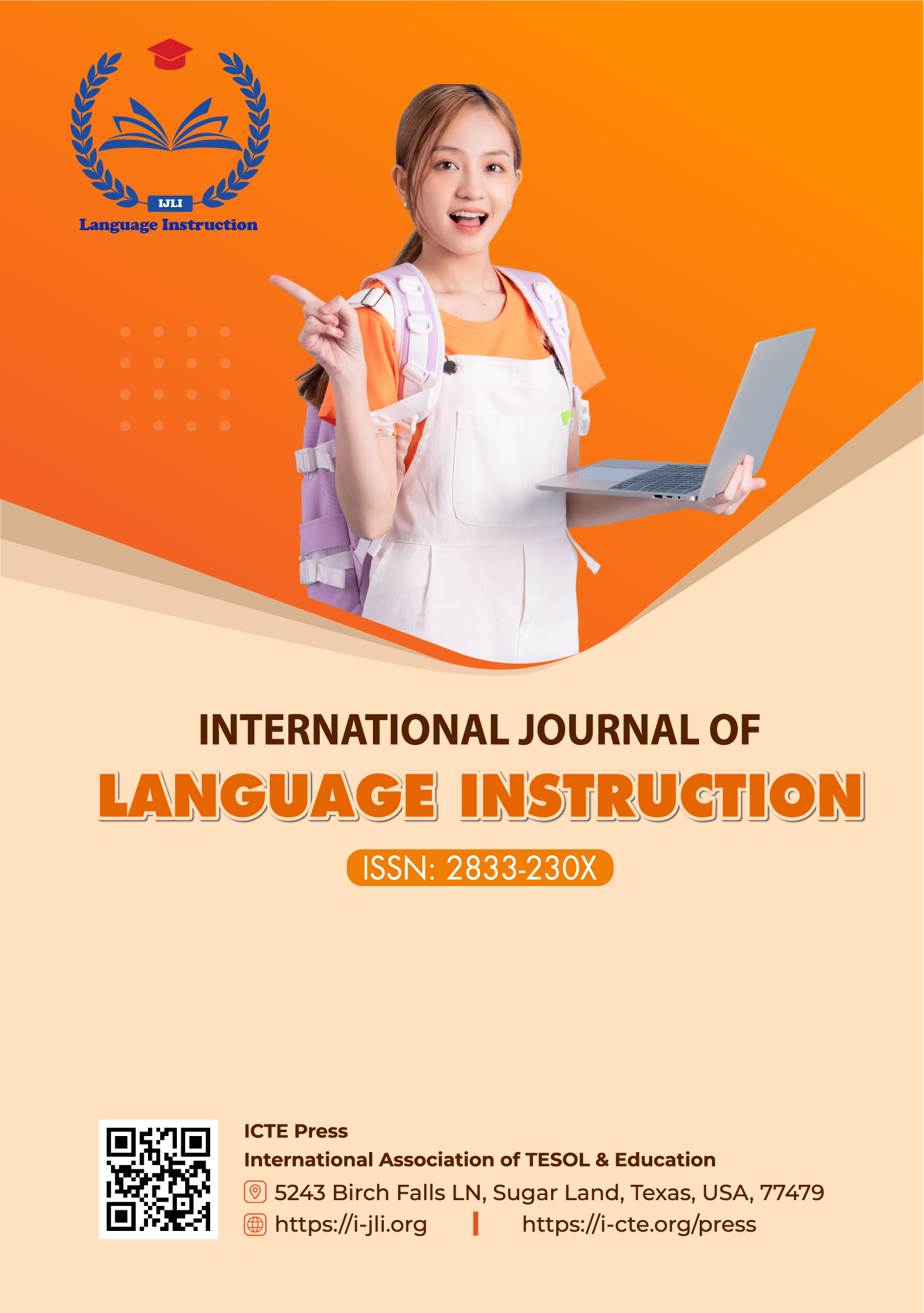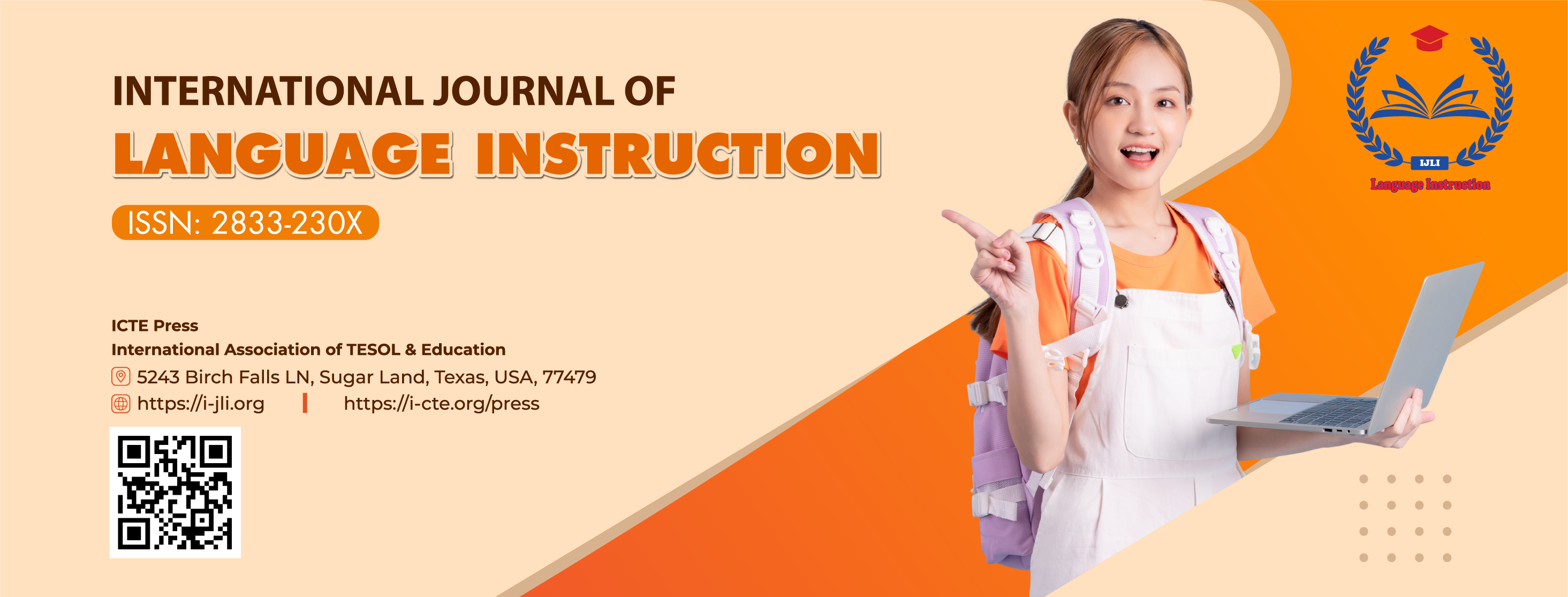Students’ Perceptions of Kahoot!, Gamification, and the Role of Instructor in Online French as a Foreign Language Classes in Jamaica
DOI:
https://doi.org/10.54855/ijli.25431Keywords:
Gamification, Kahoot!, Motivation, French as a foreign language, JamaicaAbstract
Gamification is a pedagogical tool that has brought much value to teaching and learning, including foreign languages (FLs), and serves to keep students engaged and motivated. Tools such as Kahoot! have gained much traction in FL contexts, with many studies focusing on their relation to learner enthusiasm and participation. However, the available data focuses primarily on the role of the teacher. The authors sought to gain students’ perspectives of Kahoot! in online French classes and the role of the instructor in the process. Sixteen undergraduate students at the University of Technology, Jamaica responded to a questionnaire. The study used a mixed-methods research design. Qualitative content analysis was employed to analyze the qualitative data, while descriptive statistics were used to analyze the quantitative data. Major findings reveal that Kahoot! is beneficial to FL learning, as it helps to improve students’ vocabulary, grammar, pronunciation, and cultural competence. Kahoot! also aids in the application, retention, and reinforcement of knowledge. However, technical and internet connectivity issues can impact the game’s flow. The teacher is responsible for preparing and facilitating the game strategically, as well as reviewing the answers with the students in a manner that promotes metacognition.
References
Aidoune, Y., Nordin, N. R. M., & Singh, M. K. a. S. (2022). Effect of online English learning game ‘Kahoot’ on L2 undergraduate learners in a Malaysian university. Journal of Intercultural Communication, 22(3), 13–18. https://doi.org/10.36923/jicc.v22i3.66
Alawadhi, A., & Abu-Ayyash, E.A.S (2021). Students’ perceptions of Kahoot!: An exploratory mixed-method study in EFL undergraduate classrooms in the UAE. Education and Information Technologies, 26, 3629–3658. https://doi.org/10.1007/s10639-020-10425-8
Alexander, C.J., Crescini, W.M., Juskewitch, J.E., Lachman, N., & Pawlina, W. (2009). Assessing the integration of audience response system technology in teaching of anatomical sciences. Anatomical Sciences Education, 2(4), 160-166. https://doi.org/10.1002/ase.99
Anane, C. (2024). Impact of a game-based tool on student engagement in a foreign language course: a three-term analysis. Frontiers in Education, 9, 1-15. https://doi.org/10.3389/feduc.2024.1430729
Basnet, B. (2022). Application of the positive reinforcement to enhance the learnability of EFL learners. Journal of Durgalaxmi (JDL), 1(1), 125-130. https://doi.org/10.3126/jdl.v1i1.57109
Bicen, H., & Kocakoyun, S. (2018). Perceptions of students for gamification approach: Kahoot as a case study. International Journal of Emerging Technologies in Learning (iJET), 13(2), 72–93. https://doi.org/10.3991/ijet.v13i02.7467
Budhwar, K. (2017). The role of technology in education. International Journal of Engineering Applied Sciences and Technology, 2(8), 55-57. https://www.ijeast.com/papers/55-57,TESMA208,IJEAST.pdf
Campbell, S., Greenwood, M., Prior, S., Shearer, T., Walkem, K., Young, S., Bywaters, D., & Walker, K. (2020). Purposive sampling: complex or simple? Research case examples. Journal of Research in Nursing, 25(8), 652-661. https://doi.org/10.1177/1744987120927206
Caruana, L. F., & Żammit, J. (2024). Exploring beliefs, motivations and emotions: Insights from learning Maltese as a second language. Language Teaching Research, 1-33. https://doi.org/10.1177/13621688241289724
Chaiyo, Y., & Nokham, R. (2017). The effect of Kahoot, Quizizz and Google Forms on the student's perception in the classrooms response system. International Conference on Digital Arts, Media and Technology (ICDAMT), Chiang Mai, Thailand, 178-182. https://doi.org/10.1109/icdamt.2017.7904957
Christopoulos, A., & Mystakidis, S. (2023). Gamification in Education. Encyclopedia, 3, 1223–1243. https://doi.org/10.3390/encyclopedia3040089
Creswell, J. W. (2014). Research Design: Qualitative, Quantitative and Mixed Methods Approaches (4th ed.). Sage Publications Ltd. https://www.ucg.ac.me/skladiste/blog_609332/objava_105202/fajlovi/Creswell.pdf
Crouch, C. H., & Mazur, E. (2001). Peer instruction: Ten years of experience and results, American Journal of Physics, 69(9), 970-977. https://doi.org/10.1119/1.1374249
Dewaele, J. M., and Li, C. (2021). Teacher enthusiasm and students’ social-behavioral learning engagement: the mediating role of student enjoyment and boredom in Chinese EFL classes. Language Teaching and Research, 25(6), 922-945. https://doi.org/10.1177/13621688211014538
Iqbal, M., & Lodhi, M. A. (2024). Teaching English through "Kahoot" technology in ESL classroom. Harf-o-Sukhan, 8(1), 1065-1075. https://harf-o-sukhan.com/index.php/Harf-o-sukhan/article/view/1741
Fischer, S., & Barabasch, A. (2020). Gamification.: A Novel Didactical Approach for 21st Century Learning. In E. Wuttke, J. Seifried, & H. Niegemann (Eds.), Vocational Education and Training in the Age of Digitization: Challenges and Opportunities (1st ed., pp. 89–106). Verlag Barbara Budrich. https://doi.org/10.2307/j.ctv18dvv1c.8
Gheyle, N., & Jacobs, T. (2017). Content Analysis: a short overview. Internal research note, Centre for EU Studies, 1-17. https://doi.org/10.13140/RG.2.2.33689.31841
Gil-Acirón, L. Ángel. (2022). Benefits of gamification in second language learning. [Beneficios de la gamificación en el aprendizaje de segundas lenguas]. Epos: Revista de filología, 38, 103–126. https://doi.org/10.5944/epos.38.2022.33785
Hetesi, S. (2021). A comparative review of kahoot and socrative. Teaching English as a Second Language Electronic Journal (TESL-EJ), 24(4), 1-11. https://tesl-ej.org/wordpress/issues/volume24/ej96/ej96m2/
Kalleny N. K. (2020). Advantages of Kahoot! Game-based Formative Assessments along with Methods of Its Use and Application during the COVID-19 Pandemic in Various Live Learning Sessions. Journal of microscopy and ultrastructure, 8(4), 175–185. https://doi.org/10.4103/JMAU.JMAU_61_20
Kapsalis, G. D., Galani, A., & Tzafea, O. (2020). Kahoot! as a Formative Assessment tool in Foreign Language learning: A case study in Greek as an L2. Theory and Practice in Language Studies, 10(11), 1343-1350. https://doi.org/10.17507/tpls.1011.01
Kashive, N., & Mohite, S. (2023). Use of gamification to enhance e-learning experience. Interactive Technology and Smart Education, 20(4), 554-575. https://doi.org/10.1108/ITSE-05-2022-0058
Kaur, P., & Nadarajan, R. (2020). Language Learning and Teaching using Kahoot!. International Journal of Modern Education (IJMOE), 2(5), 19-28. https://gaexcellence.com/ijmoe/article/view/1718
Korkmaz, S., & Öz, H. (2021). Using KahoOt to improve reading comprehension of English as a foreign language learners. International Online Journal of Education and Teaching, 8(2), 1138–1150. https://files.eric.ed.gov/fulltext/EJ1294319.pdf
Lăpădat, L., & Lapadat, M-M. (2024). The importance of motivation in foreign language learning. Scientific Bulletin of the Politehnica University of Timişoara Transactions on Modern Languages, 22(1), 142-152. https://doi.org/10.59168/VGLE2734
Li, C. (2019). A Positive psychology perspective on Chinese EFL students’ trait emotional intelligence, foreign language enjoyment and EFL learning achievement. Journal of Multilingual and Multicultural Development, 41(3), 246–263. https://doi.org/10.1080/01434632.2019.1614187
Lin, C., & Smith, C. (2024). L2 motivation and identity in Chinese students learning a second language. Cambridge Educational Research e-Journal, 11, 196-206. https://doi.org/10.17863/CAM.114531
Liu, Y., Zhang, M., Zhao, X., & Jia. F. (2021). Fostering EFL/ESL Students’ Language Achievement: The Role of Teachers’ Enthusiasm and Classroom Enjoyment. Frontiers in Psychology, 12, 1-6. https://doi.org/10.3389/fpsyg.2021.781118
Lloyd, D. (2023). Adjusting to remote learning as a result of COVID-19: Experiences of students and teachers in Jamaica. Multidisciplinary Journal of School Education, 12(1 (23), 477-500. https://doi.org/10.35765/mjse.2023.1223.21
Madden, O. N.; Daley, J-L.; Fearon, L. (2024). Exploiting the potentials of interactive live worksheets in French online classes in Jamaica. In Y. Choubsaz, P. Díez-Arcón, A. Gimeno-Sanz, J. Hriňák, X. Liashuk, S. Pokrivčáková & H. Vančová (Eds.), CALL for Humanity - EUROCALL 2024 Short Papers, 251-260. https://doi.org/10.4995/EuroCALL2024.2024.19101
Madden, O., Sweeney, R., & Gonzales, A. (2023). Exploring the use of live interactive worksheets in foreign language classes: Perceptions of students and teachers. International Journal of Language Instruction, 2(4), 1-18. https://doi.org/10.54855/ijli.23241
Madden, O. N. (2022). Edutainment: assessing students’ perceptions of Kahoot! as a review tool in French L2 classes. In B. Arnbjörnsdóttir, B. Bédi, L. Bradley, K. Friðriksdóttir, H. Garðarsdóttir, S. Thouësny, & M. J. Whelpton (Eds), Intelligent CALL, granular systems, and learner data: short papers from EUROCALL 2022, 240-245. Research-publishing.net. https://doi.org/10.14705/rpnet.2022.61.1465
Mayor-Peña, F. C. Y., Barrera-Animas, A. Y., Escobar-Castillejos, D., Noguez, J., & Escobar-Castillejos, D. (2024). Designing a gamified approach for digital design education aligned with Education 4.0. Frontiers in Education, 9, 1-11. https://doi.org/10.3389/feduc.2024.1439879
McQuiston, J. M. (2023). Implementing Kahoot! into undergraduate political science courses. Political Science Today, 3(2), 20–21. https://doi.org/10.1017/psj.2023.32
Moreno, OCM. (2020). The Teaching of Spanish and the Use of Information and Communication Technologies (ICT) in Jamaica. UWI Quality Education Forum, 24, 236-259. https://journals.sta.uwi.edu/ojs/index.php/qef/article/view/7836/6872
Panagiotidis, P., Krystalli, P., & Arvanitis, P. (2023). Technology as a motivational factor in foreign language learning. European Journal of Education, 6(1), 69-84. https://files.eric.ed.gov/fulltext/EJ1417303.pdf
Pavelescu, L. M., & Petrić, B. (2018). Love and enjoyment in context: Four case studies of adolescent EFL learners. Studies in Second Language Learning and Teaching, 8(1), 73–101. https://doi.org/10.14746/ssllt.2018.8.1.4
Pham, T. C. (2022). Effects of using technology to engage students in learning English at a secondary school. International Journal of Language Instruction, 1(1), 86–98. https://doi.org/10.54855/ijli.22118
Plump, C. M., & LaRosa, J. (2017). Using Kahoot! in the classroom to create engagement and active learning: a game-based technology solution for eLearning novices. Management Teaching Review, 2(2), 151-158. https://doi.org/10.1177/2379298116689783
Rayan, B., & Watted, A. (2024). Enhancing education in elementary schools through gamified learning: Exploring the impact of Kahoot! on the learning process. Education Sciences, 14(3), 277 (pp 4-12). https://doi.org/10.3390/educsci14030277
Rincon-Flores, E.G.; Mena, J.; López-Camacho, E. (2022). Gamification as a teaching method to improve performance and motivation in tertiary education during COVID-19: A research study from Mexico. Education Sciences, 12(49), 1-14. https://doi.org/10.3390/educsci12010049
Shorten, A., & Smith, J. (2017). Mixed methods research: expanding the evidence base. Evidence-Based Nursing, 20(3), 74-75. https://doi.org/10.1136/eb-2017-102699
Sianturi, AD., & Hung, R-T. (2023). The Challenges of Using Kahoot! in Teaching and Learning in Higher Education – A Systematic Review. In Proceedings of the 6th International Conference on Digital Technology in Education (ICDTE '22), 72-77. Association for Computing Machinery, New York, NY, USA. https://doi.org/10.1145/3568739.3568753
Softa, V. L. (2022). Technology as a method of teaching and learning foreign languages. Intercultural Communication, 7(1), 81–90. https://doi.org/10.13166/ic/712022.4948
Staller, M. S., & Koerner, S. (2021). Beyond classical definition: The non-definition of gamification. SN Computer Science, 2(2), 88:1-7. https://doi.org/10.1007/s42979-021-00472-4
Stratton, S. J. (2024). Purposeful sampling: Advantages and pitfalls. Prehospital and Disaster Medicine, 39(2), 121–122. https://doi.org/10.1017/S1049023X24000281
Suchman, E., Uchiyama, K., Smith, R., & Bender, K. (2006). Evaluating the impact of a classroom response system in a microbiology course. Microbiology Education, 7(1), 3–11. https://doi.org/10.1128/me.7.1.3-11.2006
Thurairasu, V. (2022). Gamification-Based Learning as The Future of Language Learning: An Overview. European Journal of Humanities and Social Sciences, 2(6), 62-69. http://dx.doi.org/10.24018/ejsocial.2022.2.6.353
Troung, M. T., & Dinh, H. N. (2024). Using Kahoot! to Teach English Vocabulary: Benefits, Drawbacks, and Actual Impacts from Students’ Perspective. Computer Assisted Language Learning Electronic Journal (CALL-EJ), 25(2), 201-223. https://callej.org/index.php/journal/article/view/452
Tu, T. H. P. (2022). The effects of using education technology tools on learning grammar in secondary schools. International Journal of Language Instruction, 1(1), 41-52. DOI: https://doi.org/10.54855/ijli.22115
Vo, T. T. S., & Le, T. M. N. (2023). An investigation into perception of online teaching and the challenges of online teaching faced by English lecturers at Quang Trung University during COVID-19 outbreak. International Journal of Language Instruction, 2(3), 63-79. DOI: https://doi.org/10.54855/ijli.23233
Wang, A. I., & Tahir, R. (2020). The effect of using Kahoot! for learning – A literature review. Computers & Education, 149, 1-22. https://doi.org/10.1016/j.compedu.2020.103818
Wang, A. I., & Lieberoth, A. (2016). The effect of points and audio on concentration, engagement, enjoyment, learning, motivation, and classroom dynamics using Kahoot!. In Proceedings from the 10th European Conference on Games Based Learning (p. 738). Academic Conferences International Limited. https://folk.idi.ntnu.no/alfw/publications/ECGBL2016-Effect_of_points_and_audio_in_Kahoot.pdf
Wichaidit, P. R. (2025). Understanding growth mindset and chemistry mindsets of high-achieving students and the impact of influential language on learning motivation. Chemistry Education Research and Practice. https://doi.org/10.1039/D4RP00218K
Zhang, Q., & Yu, Z. (2022). Meta-analysis on investigating and comparing the effects on learning achievement and motivation for Gamification and game-based learning. Education Research International, 2022, 1-19. https://doi.org/10.1155/2022/1519880
Zhang, Q., & Yu, Z. (2021). A literature review on the influence of Kahoot! On learning outcomes, interaction, and collaboration. Education and Information Technology, 26(1), 4507–4535. https://doi.org/10.1007/s10639-021-10459-6
Downloads
Published
Issue
Section
License
Copyright (c) 2025 Oneil Madden, Rashad Higgs, Sheldon Gordon, Rovel Chambers

This work is licensed under a Creative Commons Attribution 4.0 International License.
The copyright of all articles published in the International Journal of Language Instruction (ijli) remains with the Authors, i.e. Authors retain full ownership of their article. Permitted third-party reuse of the open access articles is defined by the applicable Creative Commons (CC) end-user license which is accepted by the Authors upon submission of their paper. All articles in the ijli are published under the CC BY-NC 4.0 license, meaning that end users can freely share an article (i.e. copy and redistribute the material in any medium or format) and adapt it (i.e. remix, transform and build upon the material) on the condition that proper attribution is given (i.e. appropriate credit, a link to the applicable license and an indication if any changes were made; all in such a way that does not suggest that the licensor endorses the user or the use) and the material is only used for non-commercial purposes.
Authors are able to enter into separate, additional contractual arrangements for the non-exclusive distribution of the journal's published version of the work (e.g., post it to an institutional repository, in a journal or publish it in a book), with an acknowledgment of its initial publication in this journal.











